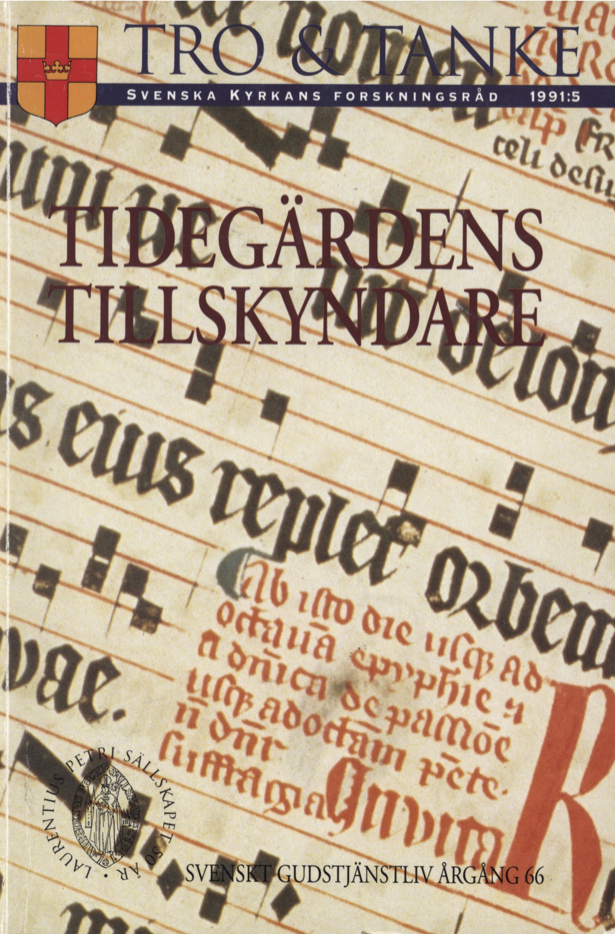Orgelns tystnad i svenskt gudstjänstliv
Abstract
The Church Law of 1686 was probably raising earlier practice to the status of law when it prescribed that all music in church should cease between Quinquagesima and Easter Day. Church organs were by this time becoming more common in Sweden, so there was particular reason for enjoining the prohibition. It applied only to the Lenten fast before Easter, but in practice it also applied to the Christmas fast and the first three Ember Days. The silence of the organ was thus a very effective way to underline the atmosphere of fasting and penance during the church year.
A royal proclamation of 1823 lifted the prohibition on church music during Lent. This was associated, on the one hand, with the publication of a new psalter in 1819, and a new hymnal in 1820-21, which vitalized church music, and, on the other hand, with the fact that confirmation had become compulsory in 1811 and communion was usually held on Quinquagesima or Good Friday, when there were many people in the churches and the organs were needed. The change in the church law in 1823 was considered a stimulus to divine service, even though it meant that the rhythm of the church year was no longer as evident as before. Long before, in 1571, a church ordinance had lifted the prohibition on bell-ringing in Holy W eek.
Church organs were also ordered to be silent when the nation was in mourning after the death of kings or queens. Weddings had to be held in the home, with no "bridal noise". Ever since the death of Maria Eleonora in 1655, special regulations have been issued concerning the silence of the organs during national mourning. Between 1792 and 1818, however, the organs were to be used as soon as the bells had stopped ringing for the dead monarch, since they were considered suitable for leading the devotions. The last time the organs were ordered to be silent was after the death of Karl XIII in 1818, five years before the change in the church law proclaiming the silence of the organs during Lent.
In the Middle Ages national mourning was probably marked by the silence of the church bells. From 1551, however, bell-ringing was made compulsory, and it went on for several hours each day, and indeed after the death of Gustaf II Adolf in 1632 the bells were rung for a whole year. After the end of Sweden’s period as a great power, however, the number of days and hours of compulsory ringing were reduced. Since the organs were silent while the bells were allowed to ring, it seems as though the sound of the bells was not perceived as music but as a form of public information. The custom of ringing the bells for dead kings is an indirect reflection of the power of the monarchy, and in the long run both have declined in significance.
When the author surveyed the practice of bell-ringing in 1951, it was still customary to ring the bells during Lent. In recent years, however, it has become increasingly common in Sweden and Finland for both bells and organs to be silent on Good Friday. The instructions for the new order for divine service in 1986 show that the church leaders have once again realized that refraining from organ music can create a suitable effect during divine service on Good Friday, like other customs such as removing the tablecloth from the altar, putting out the lights, and placing a crown of thorns on the altar crucifix. An investigation of practice shows that the silence of the organs has become more common in both the Swedish and the Finnish church in the 1970s and 1980s. Church practices like these, which were first introduced by high church people, now arouse little controversy. They can be included in the category of ceremonies which, according to the reformer Laurentius Petri, can equally well be followed or ignored in an evangelical church.
Downloads
Published
Issue
Section
License
© the authors, Laurentius Petri Sällskapet för Svenskt Gudstjänstliv and Artos & Norma Bokförlag. Copying and using material from Svenskt Gudstjänstliv for scholarly purposes is permitted as long as the source is indicated. For other uses, please contact the respective author as well as the publisher. Special restrictions may apply to images.


